
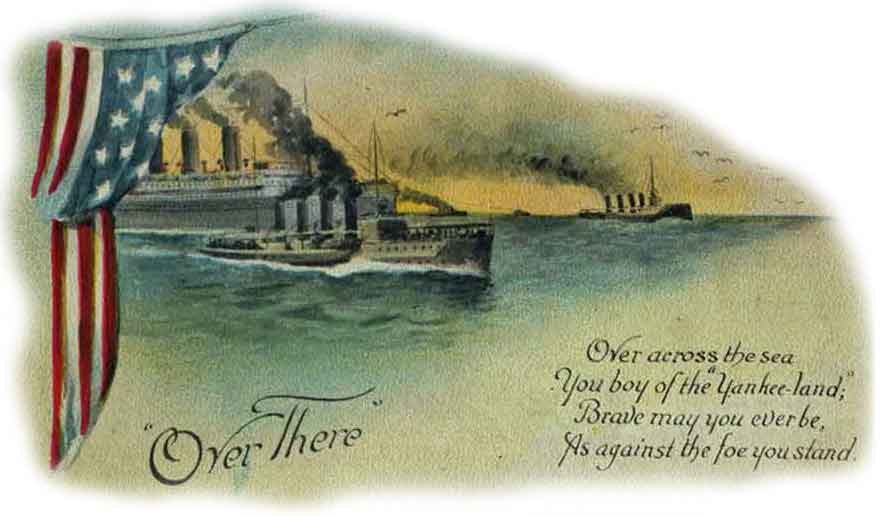
In Autumn 1918, World War One was drawing to a close. Europe was devastated, and the Allies prepared for victory. The massive industrial and military might of the United States had tipped the balance in their favour.
In Ireland, which at that time was still part of the United Kingdom, the seas were finally being controlled by the Royal Navy with the overwhelming support of the united Sates Navy.
Cork, on the south coast of Ireland, had become the hub of operations against the marauding u-boats in the western Atlantic. The British naval forces had been augmented with American destroyers, submarines, submarine chasers, naval aviation forces, and a battleship force.
In October 1918, a very conservative estimate of the numbers of US naval personnel in Cork alone, can be put at a staggering 9,013. This figure is based on average manning for:
23 Destroyers (2415)
2 Destroyer Tenders (721)
3 Battleships (2729)
30 Subchasers (780)
US Submarine Force, Berehaven (347)
USNAS Aghada (1500)
USNAS Whiddy (418)
USNAS Berehaven (103)
The presence of so many US personnel put the existing medical infrastructure in the Cork Harbour area under great strain. From the arrival of these forces in May 1917, healthcare facilities had been shared between the British Naval Hospital in Haulbowline and the local hospital in Queenstown (now Cobh Community Hospital).
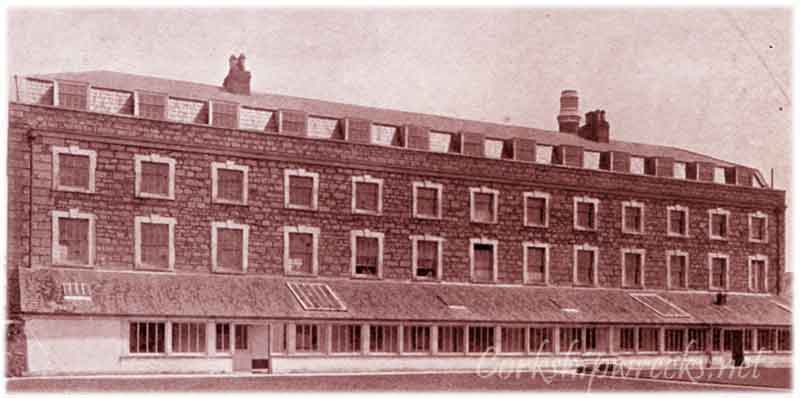
Haulbowline Naval Hospital in 1904
These facilities were only barely able to cope with the increase in serving personnel, as well as injured seamen and civilians from the war at sea
The destroyer tender USS Melville based in Cork Harbour from 1917 to 1918, had a hospital service on board, and treated many US seamen, but it was not equipped or able to deal with contagious diseases such as influenza.
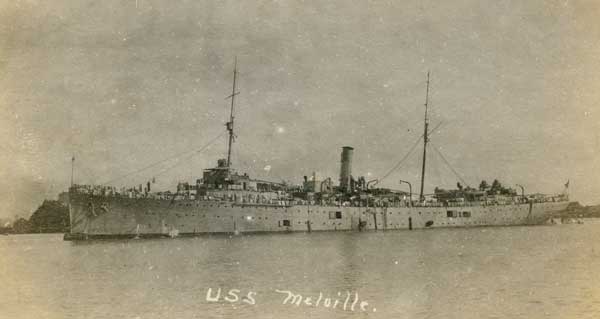
USS Melville and destroyers in Cork Harbour
At a present count, based on varied sources, over 198 US Naval personnel, based in Cork, Ireland, lost their lives between May 1917 and April 1919. Causes varied from accident or illness, to enemy action. Casualty list Here
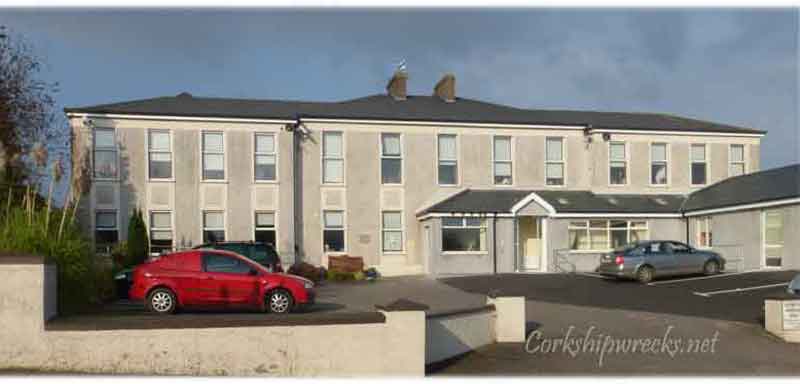
The former Queenstown Hospital - now Cobh Community Hospital.
In December 1917 Charles Minor Blackford, serving on USS McDougal , was taken ill with influenza. He was sent to Queenstown General Hospital, run by the Bon Secours nuns, which he described as "a grim stone building topping the ridge overlooking Queenstown". Conditions in this institution were poor, with constant cold, and toilet facilities of the 'long drop' type.
There was only enough hot water for one shower for 12 men per day. This was combined with poor food and (in American eyes) substandard medical care.
The US Navy was charged one British Pound per day for each patient. By early 1918, the British military hospital at Haulbowline Island was extended, and US patients were moved there.
With the expansion of US Forces in 1918, it was clear that a dedicated hospital was needed for US naval personnel. The British War Office acquired White Point House and twelve acres of land, opposite Haulbowline Island, under the Defence of the Realm Act.

Location of Whitepoint, in Cork Harbour.
The entire hospital was prefabricated and shipped from the USA. The materials arrived in Queenstown on the 24th of May 1918, and work quickly began. The construction consisted of 50 hutment units, from which the hospital buildings were made. Construction was undertaken by naval forces with no civilian contractors used.
Obtaining clean water was problematic, and several well bores were run without success Eventually Admiral Sir Lewis Bayley, Commander in Chief of Western Approaches, gave permission for the Haulbowline water supply, from Spy Hill reservoir , to be tapped. As freshwater was in short supply, salt water was pumped from the sea at White Point into holding tanks for latrines and fire fighting services
The hospital consisted of :
7 Main wards. 128 feet x 20 feet. One ward contained 40 beds, two toilets, two shower baths and a urinal. All hutments had electricity, and central heating radiators. Total capacity of the hospital was 250 beds.
Two operating pavillions, each consisting of operating,room, etherizing room, and sterilizing room.A cluster of five 50 candle power lamps under a reflector furnished illumination.
Mess room
Hospital corps barracks
Chapel
Red Cross Room
Brig
Various store rooms
The YMCA provided a building containing a barber shop, reading and pool room,a canteen, and a stage
There was accommodation needed for the 30 nurses stationed at White Point. Mrs C.Hathaway, wife of the American Consul, and Mrs P.C.McFarlane, supervised the refurbishment of White Point House as a nurses home. When complete it only had a capacity of 18, the other nurses were accommodated in a hutment nearby.

Whitepoint, then and now
The staffing of the hospital was accomplished by drawing from the Providence, Rhode Island, Navy Red Cross, and the personnel were firstly trained in the naval hospital Newport, Rhode Island. This was organised under the direction of Lieutenant Commander G.A. Matteson MC, USNRF. When in operation, the hospital was to have a staff of 149, which included 30 nurses.
The unit of 38 nurses sailed for Europe on the 23rd of September 1918, under the charge of chief nurse Grace McIntyre. They travelled on the Union-Castle Line steamer RMS Briton . The passengers also included 2200 American troops, destined for war service.
RMS Briton
There was an outbreak of influenza on board. It spread quickly, and soon there were 160 stricken soldiers. The nursing staff volunteered their services, and brought the situation on board under control. They were commended by the Officer in Charge, Colonel Ottwell. The nurses landed in Liverpool and were transferred to Ireland.
United States Navy Base Hospital no 4 Queenstown, Ireland, opened on the 11th of October, and the first task for the nursing staff was dealing with the injured men from the collision between the USS Shaw and the Aquitania , two days previously.
After this the main business at hand in the hospital was dealing with the influenza epidemic of 1918 and 1919 which was at it's height. It struck mainly young fit able bodied people, and the military life of close proximity living, provided an ideal means of spreading the disease.
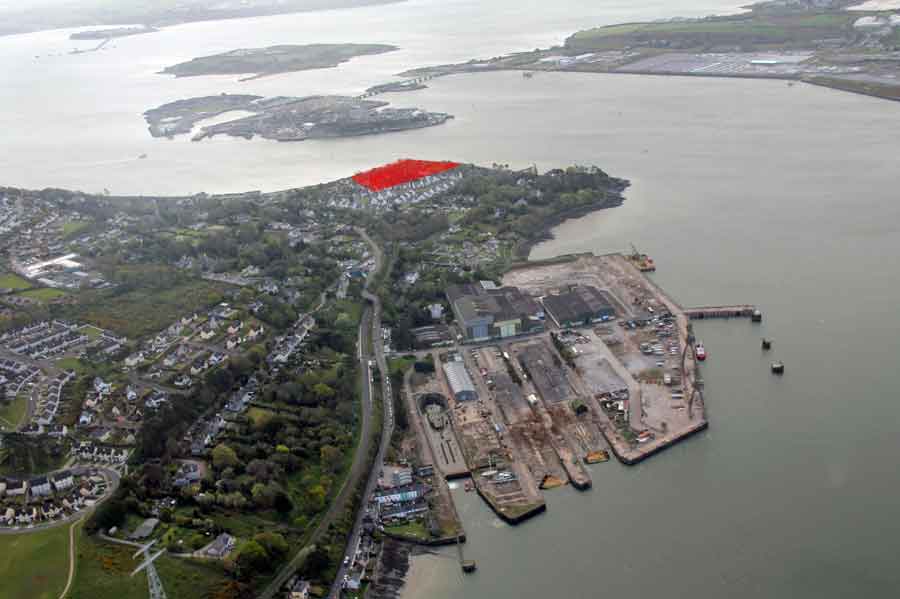
Location of the hospital and grounds
From the beginning, the hospital was operating at capacity. Two nurses were detached for duty to Berehaven, for treating those servicemen too ill to travel to Cork. Two more were sent to assist the staff at the British Naval Hospital on Haulbowline Island, in the harbour.
The hospital was under the command of Captain Dudley N. Carpenter, Medical Corps, USN. He was later awarded the Navy Cross, for his services in Ireland.
Staff of US Base Hospital No4, Queenstown, Ireland.
|
Lieut.-Commander Lucius W.Johnson, Medical Corps, USN Lieutenant George A. Eckert, Medcal Corps, USN Lieutenant Thomas D.Baxter, Medical Corps, USN Lieutenant Rodney J. Youngkin, Medical Corps, USN Ensign H.T.C. Welsh, Pay Corps, USNRF Pharmacist Fred C.Duncan, USN Lieutenant George A. Eckert, Medcal Corps, USN Lieutenant Thomas D.Baxter, Medical Corps, USN Lieutenant Rodney J. Youngkin, Medical Corps, USN Ensign H.T.C. Welsh, Pay Corps, USNRF Pharmacist Fred C.Duncan, USN |
|---|
ARTIFICER BRANCH
| William E. Lucas CMM USNRF Alfred Buckley, Jnr. CMM USNRF Robert Lucas CMM USNRF Norman Thorpe CMM USNRF Peter L. Thompson Eng 1C USN George C.Greene MM 1C USNRF John Rhodes S.Fit 1C USNRF Thomas P. Clark S.Fit 1C USNRF Harold E.Peck El 1C USNRF Sante Moise MM 2C USNRF Don E. Whittier MM2C USN William M. Kelos El 2C USNRF Ellsworth E. Nance CM 2C USNRF Edwin Anderson CM2C USNRF Elmer O.Johnson F 1C USNRF Max L. Strong F 1C USN Frank Till F 1C USN William C.Chambers F 2C USN Maurice E.Irish F2C USN Heber B.Moore F3C USN |
|---|
YEOMAN BRANCH
| Stephen E.C. Kendrick Chief Yeoman USNRF William J. Hammond Chief Yeoman USNRF Arthur J. Xavier Chief Yeoman USNRF John C. Moran Yeoman 1C USN Worley M.Arwood Yeoman 1C USN John A.Ripp Yeoman 1C USNRF Paul V. Costello Yeoman 1C USNRF Sidney W. Wray Yeoman 1C USNRF Leo K. Hill Yeoman 1C USNRF Jules H.Rosenberg Yeoman 1C USNRF Jesse O. Sandlin Stkpr 1C USN Christopher T. Nolan Yeoman 2C USNRF Theodore J. Copelof Yeoman 2C USNRF George L. Howe Yeoman 3C USNRF William L. Downey Lds Yeo USNRF |
|---|
HOSPITAL CORPS
|
Alfred F.Brisson CPM USN Elmer Schwinn CPM USN John P.Bennett PhM2 USN Wallace R.Boren PhM2 USN Lewis T. Brookshire PhM2 USN Guy W.Holly PhM2 USN Thomas R. Mc Carthy PhM2 USN Thomas A.Pariseau PhM2 USN Elven W.Scott PhM2 USN Josiah Shropshire PhM2 USN John G.Sinclair PhM2 USN Robert E.Van Clief PhM2 USN Stephen Bauer PhM3 USN John Bennett PhM3 USN Floyd G.Desch PhM3 USN Elmer V.Eckland PhM3 USN Charles G.Goold PhM3 USN Paul A.Haring PhM3 USN Rupert B.Hinton PhM3 USN George W.Jackson PhM3 USN Albert R.Nisely PhM3 USN Edgar C.Perkerson PhM3 USN Kenneth L. Pugh PhM3 USN Gradye L. Welborne PhM3 USN Nathan S.White PhM3 USN Paul H,White PhM3 USN Armour D.Wright PhM3 USN Twig Henderson HA1 USN Sidney L.Johnson HA1 USN Frank P. Kern HA1 USN Russel R.Roberts HA1 USN Harry E.Sprankle HA1 USN William Suter HA1 USN Fay A.Sweet HA1 USN Valdes A. White HA1 USN Harland A.McCarthy CPM USNRF Paul C.Dickert PhM2 USNRF Harry B.Murray PhM2 USNRF Robert M.Aylsworth PhM3 USNRF Linton B.Brown PhM3 USNRF Harry V.Byrne PhM3 USNRF John R.Cheetham PhM3 USNRF Alfred Fox PhM3 USNRF Wilfred M.Hamill PhM3 USNRF Harry A.Noel PhM3 USNRF Edgar J.Staff PhM3 USNRF Frederick E.Walker PhM3 USNRF George H.Bristol HA1 USNRF Byron A.Cole HA1 USNRF Charles D.Flagg HA1 USNRF Robert W.Nelson HA1 USNRF Edmund J.Tanner HA1 USNRF James F.Lavery HA1 USNRF |
|---|
COMMISSARY BRANCH
|
Walter H.Kelly CC Std USN Clarence R.Lewis Bak 1 USN Rodger O’Mott SC1 USN Frederick A.Tucker SC1 USN Peter A.Carr SC1 USNRF William F.Durvin SC1 USNRF Peter A.Carr SC1 USNRF Peter H. Mitson SC1 USNRF Joseph Mori SC1 USNRF John P.Ormond SC1 USNRF James P. Duffy SC2 USNRF Frank D.Hurley SC2 USNRF Michael Moretti SC2 USNRF Archibald M.Morrison SC2 USNRF Lawrence H.Smith SC2 USNRF William T.Cashin SC3 USNRF Joseph E. Donahue SC3 USNRF Edward V.Kilduff SC3 USNRF Edward A.Madden SC3 USNRF Ralph L.Smith SC3 USNRF John R.Oneal SC3 USNRF William H.Ward, jnr. SC3 USNRF Charles H.Jones W.R.Std USNRF Philip Houle M. Att1 USNRF |
|---|
RED CROSS NURSING STAFF
(From Providence, R.I.)
|
Grace McIntyre - Chief Nurse Ruth E.Anthony, Ada Gertrude Ayers, Rose V. Basso, Marilla Berry, Corine L. Bouchard, Annie Bovair, Ethel E.Briggs, May Bright, Reba Alice Brown, Ruth Carter, Eva May Clement, Gertrude E.Craig, Deery, Anna T.Degnan, Claire E.Du Brau, Margaret G.Evans, Ruth Graham, Janie Grant, Mary Jenkins, Mabel B.Johnson, Olga D.Johnson, Constance Martin, Juliana J.Murphy, Mary Agnes Murphy, Ella M.W.McCanna, Annie McCaughey, Margaret D. McCaughey, Mary R.McIntyre, Hilga S.Nelson, Mary E.Olding, Esme Ruth Peckin, Nellie B, Rippen, Margaret E.Ross, Thelma Selfridge, Isabel Tait, Maria Eiisia Trimble, Alma E.Ulrich, Rugh M.Wallen, Alice L.Ward, (Nursing Staff Names Courtesy of Jean Shulman R.N.) |
|---|
By the Armistice, in November 1918, hospital spaces for US Naval personnel in Cork Harbour had expanded, and consisted of:
USN Base Hospital No 4, Whitepoint.
USS Melville,
USNAS Aghada
Royal Naval Hospital, Haulbowline.

Menu Card, 1919.
On the 3rd of January,1919, Admiral Sims, Commander of US Naval Forces in Europe visited Whitepoint Hospital. A number of the patients, who were deemed fit enough, were removed to the mother-ship USS Melville , which left ireland on the 6th of January, for Boston.

Whitepoint House, then and now
The United States Navy vacated the hospital in March 1919. The British War Office immediately took over the area. With the departure of the United States forces, some the huts were quickly taken down and sold off locally. A number of huts were retained by the British Forces, and used to billet troops. The unique feature of central heating made them far preferable to the Belmont Hutments, in the east of the town.
By November 1919, the British War Department was advertising for grazing on the 12 acre site. In 1920, during the Irish War of Independence, the Cameron Highlanders were stationed at Whitepoint.
In the 1920s' and 1930s' Whitepoint came under consideration for the deveopment of a 'Lido' type swimming pool along the shore line, and later as a station for an intrenational flying boat base. Neither of these plans came to fruition
In the 1970s', a large part of the former hospital site was acquired by the Local Authority for housing

Whitepoint
SOURCES
There have been a number of publications detailing the history of Queenstown (Cobh) during World War One. The standard reference works are those those listed below
Danger Zone. The story of the Queenstown Command.
By E.Keeble Chatterton
Little, Brown and Co, Boston 1934
(copy available in Cork City Library – local history section top floor)
The Victory at Sea. By Rear-Admiral William Sowden Sims, Doubleday, Page and Company, New York, 1921.
Simsadus London, The American Navy in Europe.
By John Langdon Leighton.
Henry Holt & Co, New York, 1921.
Available to download here
Annual Report of the Secretary of the Navy
For the Fiscal Year, 1918
Available to download here
Officers and Enlisted Men of the US Navy who died during WW1
Available to download here
Bayley’s Navy,
by Vice Admiral Walter.S.Delany (Rtd)
Available to download here
American Participation in the Great War,
by Captain Dudley W.Knox.
Available to download here
Naval Aviation in WW1,
by Adrian O. Van Wyen.
Available to download here
For Operational Records Various files from the Public Records Office,of the United Kingdom, Kew are invaluable, especially records of ADM137, which were files bound for the official history of WW1 Naval Operations. None of these records are digitised yet, and can only be accessed by visiting the British Public Records Office, Kew, near London.
www.nationalarchives.gov.uk/
For photographs of the Queenstown Command, the following websites have many photographs available to download free of charge. Most of the aforementioned publications also have photographic illustrations.
US Naval History and Heritage Command website
www.history.navy.mil
United States National Archives Website
www.archives.gov/
The British Imperial War Museum
www.iwm.org.uk/research
This site contains many photographs of US and British Naval operations in Ireland. Importantly, it also has a number of copies of unique newsreel footage. These can be played on the site.
